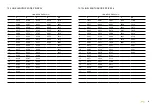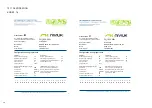
11
4.1 FLYING IN TURBULENCE
The KODE P has an excellent profile to buffer turbulence. It is very stable
in all conditions and has excellent passive flight reactions, which makes it
very safe in turbulent conditions.
All paragliders must be piloted for the prevailing conditions and the pilot is
the ultimate safety factor.
We recommend active flying in turbulent conditions, always taking
measures to maintain control of the wing, preventing it from collapsing
and restoring the speed required by the wing after each correction.
Do not correct the glider (braking) for too long in case this provokes
a stall. If you have to take corrective action, make the input then re-
establish the correct flying speed.
4.2 POSSIBLE CONFIGURATIONS
We recommend learning to fly this wing under the guidance of a qualified
instructor. The pilot must adapt their use of the brakes depending on the
wing-loading and avoid over-steering.
It is important to point out that the appropriate response to an adverse
incidence can vary from size to size; even within the same size at
maximum or minimum load the behaviour and reactions of the
wing may vary.
In the test report, you will find all the necessary information on how to
handle your new wing during each of the tested manoeuvres. Having this
information is crucial to know how to react during incidents in real flight,
so you can deal with these situations as safely as possible.
Asymmetric collapse
In spite of the KODE P’s profile stability, strong turbulent air may cause
the wing to collapse asymmetrically, especially if the pilot is unable to fly
actively and prevent the collapse. In this case the glider conveys a loss of
pressure through the brake lines and the harness. To prevent the collapse
from happening, pull the brake handle corresponding to the affected side
of the wing. It will increase the incidence of the wing (angle of attack). If
the collapse does happen, the KODE P will not react violently, the turning
tendency is gradual and easily controlled. Weight-shift toward the open,
flying side (the opposite side of the collapse) to keep the wing flying
straight, while applying light brake pressure to that side if necessary.
Normally, the collapsed side of the wing should then recover and reopen
by itself. If it does not, then pull the brake handle on the collapsed side
decisively and quickly all the way (100%) down. You may have to repeat
this pumping action to force the re-opening of the deflated glider side. Do
not over-brake or slow down the flying side of the wing (control the turn).
Once the collapsed side is open make sure you return to the
default flying speed.
Frontal collapse
Due to the KODE P’s design, in normal flying conditions frontal collapses
are unlikely to take place. The wing’s profile has great buffering abilities
when dealing with extreme incidence changes. A frontal collapse may
occur in strong turbulent conditions, entering or exiting powerful thermals
or when lacking experience using the speed-bar without adapting to the
prevailing conditions. Frontal collapses usually re-inflate without the glider
turning, but a symmetrically applied quick braking action with a quick
deep pump of both brakes will accelerate the re-inflation if necessary.
Release the brake lines immediately to return to default glider air speed.
Negative spin
A negative spin does not conform to the KODE P’s normal flight
behaviour. Certain circumstances however, may provoke a negative spin
(such as trying to turn when flying at very low air speed whilst applying












































